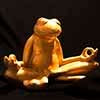Ever since 1927, Time magazine reveals its choice of Person of the Year (formerly Man of the Year till 1998) by its editors at the end of every year for the person or persons “who most affected the news and our lives, for good or ill, and embodied what was important about the year.”
 Almost half a century later in the December 14th 2011 issue, Time magazine chose The Protester as the 2011 Person of the Year. The cover story recounted the waves of protests like brush fire such as the Arab Spring from Tahrir Square of Cairo in Egypt to streets of Damascus in Syria, and those in Europe from streets of Madrid, Athens to London and Moscow, and in U.S., the movement of Occupy Wall Street. The cover story notes that “All over the world, the protesters of 2011 share a belief that their countries' political systems and economies have grown dysfunctional and corrupt — sham democracies rigged to favor the rich and powerful and prevent significant change. ”Unlike the Inheritors of 1966, there is no ideological consistency and it is global this time. The most indicative of all and the one thing the Protestors do share in common is what Time’s quote of Miral Brinjy, a 27-year-old blogger and TV-news producer who grew up in Saudi Arabia: "I know what I don't want."
Almost half a century later in the December 14th 2011 issue, Time magazine chose The Protester as the 2011 Person of the Year. The cover story recounted the waves of protests like brush fire such as the Arab Spring from Tahrir Square of Cairo in Egypt to streets of Damascus in Syria, and those in Europe from streets of Madrid, Athens to London and Moscow, and in U.S., the movement of Occupy Wall Street. The cover story notes that “All over the world, the protesters of 2011 share a belief that their countries' political systems and economies have grown dysfunctional and corrupt — sham democracies rigged to favor the rich and powerful and prevent significant change. ”Unlike the Inheritors of 1966, there is no ideological consistency and it is global this time. The most indicative of all and the one thing the Protestors do share in common is what Time’s quote of Miral Brinjy, a 27-year-old blogger and TV-news producer who grew up in Saudi Arabia: "I know what I don't want."There is no doubt that such discontent and frustration expressed on the street have been simmering for quite sometimes and have reached boiling point in 2011. All they were waiting for was another straw or a spark. For the Arab Spring, it was literally the self-immolation of Mohamed Bouazizi when he set himself on fire with gasoline and a match in desperation. In Occupy Wall Street, it was the peaceful protest initiated and planned by the Canadian activist group Adbusters at the Zuccotti Park near Wall Street with the sole purpose to draw attention to the growing income and wealth inequality. But you can easily trace it back to preceding years as seen in the Tea Party movement, or as expressed earlier by singer and song writer James McMurtry in his 2006 AMA (American Music Association) Song of the Year - "We Can't Make It Here" below (see the lyrics here)
There is no doubt that Internet and social media have brought the potential and dynamics of crowd forming to a new level. And there is no doubt that accelerated news cycle and increasing sensationalism by mass media has fueled and incited extreme reactions and promoted polarizations, intentionally or not.
The potential for destruction of the power of crowd has always been feared by many especially those who are in power and favor status-quo. Occasionally, we find few crafted ones such as Adolf Hitler and Mao Zedong who made use of the crowd psychology like suggestibility and contagion to advance their agenda and position at the national scale. Crowds by definition are transient and dynamic. The emotion can explode and dissipate in no time with few memorable moments or meanings in between.
 How many of us still remember the Vancouver riot 6 months ago? To jug your memory, here is the famous photo of the Kissing Couple of the Vancouver Riot that was just named by Esquire magazine the Photo of the Year 2011.
How many of us still remember the Vancouver riot 6 months ago? To jug your memory, here is the famous photo of the Kissing Couple of the Vancouver Riot that was just named by Esquire magazine the Photo of the Year 2011.Gustave Le Bon, the French social psychologist and pioneer of crowd psychology, told us more than 100 years ago in his influential 1895 book La psychologie des foules(English translation The Crowd: A Study of the Popular Mind) that one key characteristic of crowd is that it “can never accomplish acts demanding a high degree of intelligence.”He observed that crowd is formed when the heterogeneous intellectual individuals are overwhelmed and taken over by common ordinary quality of unconsciousness. Have you ever had the temptation or encouraged by the anonymity and done something that you normally wouldn’t do when you disappeared into a crowd?
Now year 2011 is coming to an end, the more challenging and open question is if and how the energy of the Protestor can and will be transformed into positive lasting changes and new orders. The alternative would be painful but sometimes necessary, which is to go through the full cycle of the crowd development from snowballing to crashing, followed by opportunities to rebuild the new from ashes.
Wish you Happy Holidays and Exciting New Year!







